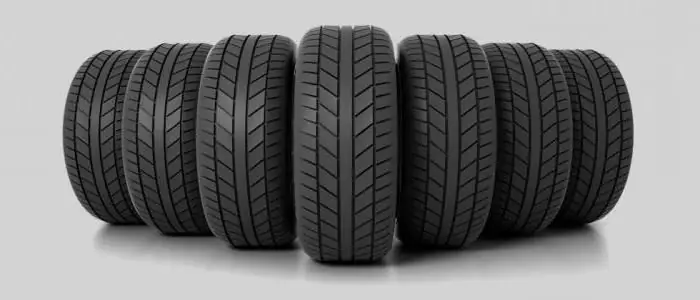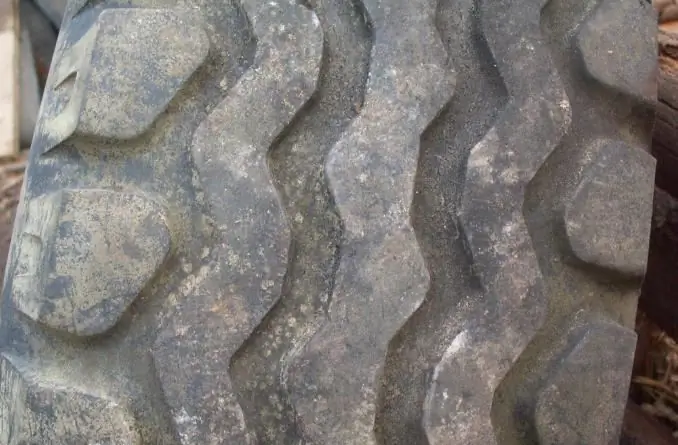2025 Author: Erin Ralphs | [email protected]. Last modified: 2025-01-22 21:14:13
Twice a year, cars are "changed shoes", and their owners are faced with the question: "How to store rubber?" Tires do not like exposure to sunlight, ultraviolet radiation, moisture and sudden changes in temperature. In addition, they are subject to deformation. In general, these are fragile products that require special handling. Therefore, storage of tires without wheels becomes a very difficult task for many car enthusiasts.

Step One: Choosing the Right Location
Where will the rubber be stored? This is the first question that the owner of the car must answer himself. In fact, everything is not as simple as it seems at first glance. Storing rubber can be a big problem if you don't have the right place. The room should have a relatively constant temperature, sudden changes are detrimental to tires. Optimum when indoors from +10 °C to +25 °C. Upper bar - +35 °C.
Another important parameter is humidity. The optimal level is about 60%. If the tires are in a damp room, they will lose their elasticity from such exposure. Overdrying is also undesirable, because. rubber may crack.

Also, the room should be protected from ultraviolet radiation and well ventilated.
Optimal places for rubber: heated garage, storage room in an apartment or house, special tire storage.
Tolerable: glazed balcony, basement. In both rooms it is necessary to control the temperature and humidity levels. The basement will need to be regularly ventilated. You can also store in attics and sheds.
Long-term storage of rubber is undesirable on an unglazed balcony or under a street canopy.
Mark Tires
Before removing, be sure to indicate where the "shoes" from each wheel. You can use the marking by the first letters: LP - left front, LZ - left rear. At the next change of rubber, you will have to take into account where the tires were and return them to their place or swap them. When they are marked, it is much easier to do so.
Pre-care
Before you leave the tires alone for a long time, you need to subject them to a little treatment. Thanks to simple operations, the rubber will still be as good as new in six months.

- Wash. Tires should not be left dirty. They need to be cleaned of dust, oil products, remove all stones from the treads, etc.
- Dry. Tires must not be stored wet. Excessive moisture damages products.
- Treat rubber with preservative compounds. They will protect the material from premature aging. It is necessary to apply chemistry strictly according to the instructions, if the recommendations are not followed.manufacturer can damage tires.
How to fold
There is only one recommendation for how to store tires without rims. Tires should be vertical, next to each other. Only in this case can deformation be avoided. It is optimal if a semicircular surface is used: this will perfectly maintain the shape. Tires will need to be rotated periodically if they are to be placed on a flat shelf or floor.

Now consider how to store rubber without disks is not recommended. It is undesirable to place rubber on cables, angles, channels, etc., as there will be only a few support points, which will lead to uneven distribution of the load and, as a result, deformation.
If you hang it on hooks, the geometry of the tire will be broken: it will become elongated.
If stacked on top of each other, the lower tires may flatten somewhat. Subsequently, they will be difficult to install. This is especially true for thin rubber.
General storage conditions
It is important to observe a number of other conditions in order to avoid problems. So, how to store rubber to avoid premature aging:

- Do not keep tires on a wet or frozen surface - only on a dry, clean floor or shelf.
- Prolonged contact with gasoline, diesel fuel, other oil products is not allowed.
- It is not recommended to place tires near radiators and other heat sources, as well as near fireand sources of sparks, such as a running welding machine.
- Avoid exposure to chemicals, paints, varnishes and solvents. It is advisable to keep all aggressive substances in another room or at a considerable distance.
- There should not be increased ozonation in the room.
Polyethylene controversy
This item is for those who do not know how to store rubber without discs on the balcony. Someone strongly recommends wrapping tires in dark bags, someone talks about the dangers of polyethylene. Actually the answer is simple. It is not so much the cellophane itself that is harmful, but the condensate that forms on its inner surface. To avoid moisture in the bag, close it loosely so that air can circulate.
Dark polyethylene can be a good helper when storing rubber on the balcony: it will protect tires from ultraviolet radiation. If the tires are in a dark and dry room, then the bags are not needed.

Currently sold special covers that can be used instead of polyethylene. It will come out a little more expensive, but such a “wrapper” is more durable, and storage conditions will be met. Covers are made of dense dark materials that do not let in sunlight, but at the same time "breathable". In this case, condensation will not appear.
How to store winter tires?
Winter tires without rims require a special approach. First of all, this concerns the temperature regime. It should be in a cool place, because. each type of tire should be stored under conditionsclose to the operating conditions. Therefore, it must not only be protected from sunlight, but also from overheating. Riding on ice requires great softness from the rubber, and when heated, it becomes stiff. An "oak" tire will not be able to provide high-quality grip.
Does it make sense to take tires to a specialized warehouse?
If there is absolutely nowhere to put tires, then you can contact specialized tire stores. There are many such services in large cities. Usually they know how to properly store rubber. But it’s better not to be too lazy and independently inspect the room where the tires will lie, find out if there is the necessary equipment: semicircular shelves, racks, hooks, etc. It would be nice to check the compliance of the declared humidity and temperature regimes with real indicators.

You also need to carefully study the contract, see what guarantees the warehouse gives, what will be done in case of loss or damage to property. Do not trust those companies that do not ensure the safety of tires or work without a contract, but simply by check.
This completes the guide on how to store tires without rims. There is nothing complicated here if you find a suitable room.
Recommended:
Seasonal motorcycle storage: storage rules and useful tips

Winter storage of a motorcycle is a topic on which a huge number of articles have been written, a lot of videos have been shot. Who would have thought that most of these tips are just advertising. Therefore, this article will provide refutation of popular recommendations for storing a motorcycle in winter
How to distinguish winter tires from summer tires: features, differences and reviews

When driving a car, safety is important. A lot depends on the right tires for the season. Many beginners who have just become motorists do not know how to distinguish winter tires from summer tires
Cheapest tires: all season, summer, winter. Good cheap tires

This article will not compare models of all-season and seasonal tires, the question of which one should be used and which one should not be raised will not be raised. Consider only the best and most inexpensive tires that can be easily purchased on the Russian market
Is it possible to drive on winter tires in summer: safety rules, tire structure and differences between winter and summer tires

There are situations in which the driver can use winter tires in the summer. This refers to wheel damage on the road. If the spare wheel in the car is studded, it is allowed to install it instead of the punctured one and drive this way to the nearest tire fitting point. For such actions, traffic police officers do not have the right to issue a fine. But you should figure out how the rubber intended for another season will behave on the road
"Toyo" - tires: reviews. Tires "Toyo Proxes SF2": reviews. Tires "Toyo" summer, winter, all-weather: reviews

Japanese tire manufacturer Toyo is one of the world's top sellers, with most Japanese vehicles sold as original equipment. Reviews about tires "Toyo" almost always differ in positive feedback from grateful car owners

